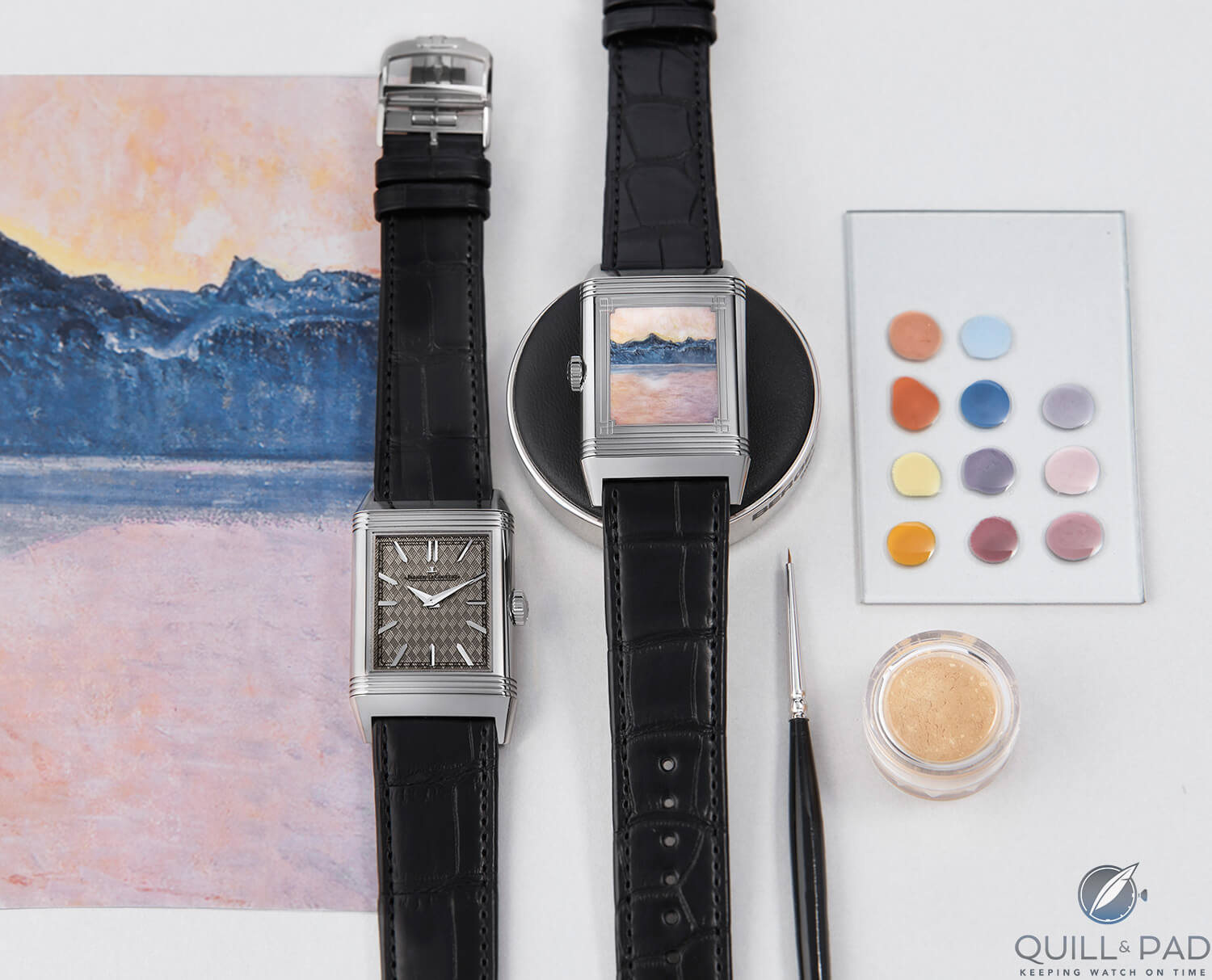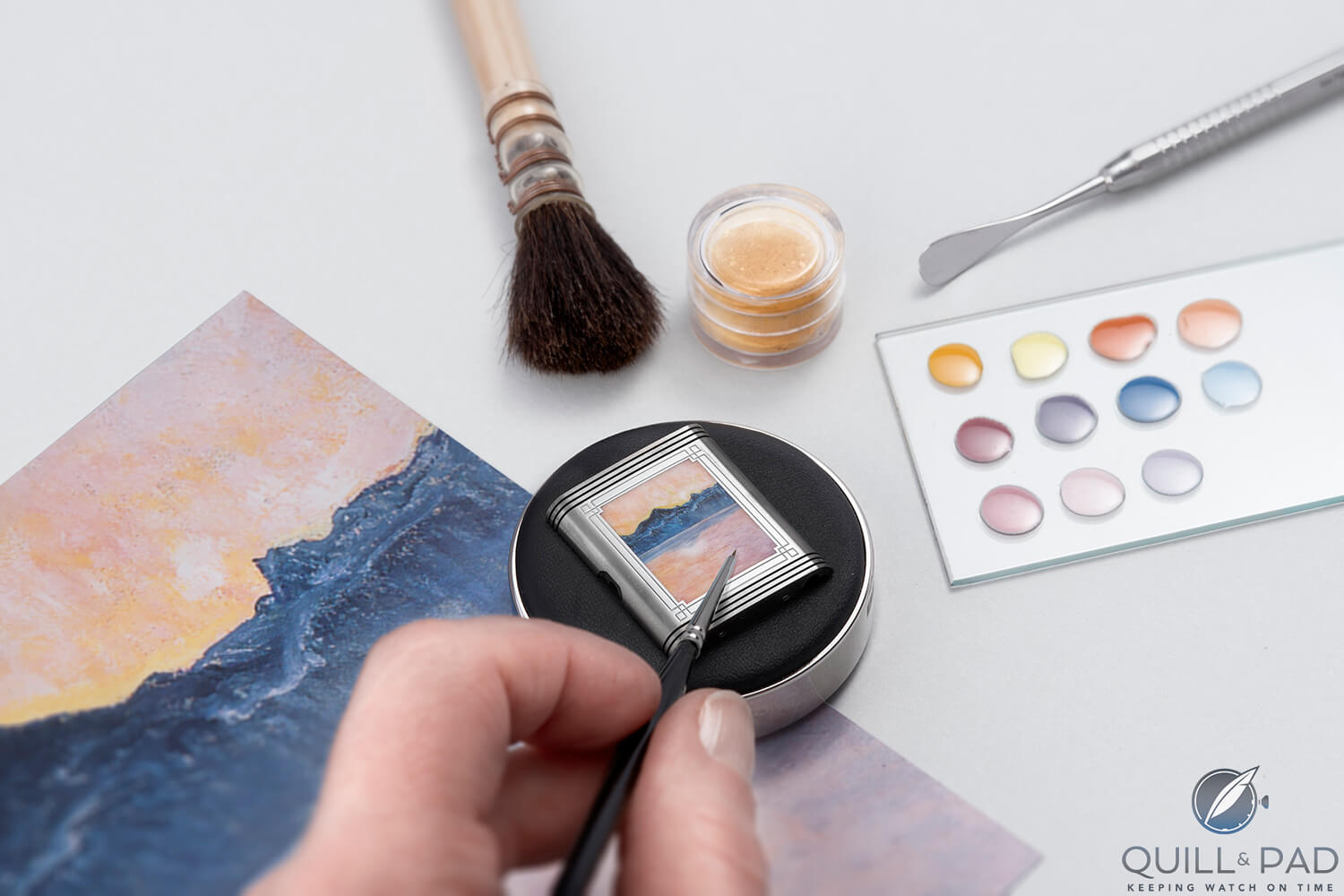Since humankind began measuring time, the arts have played a major role in the creation of timekeeping devices, from Egypt’s meticulously detailed obelisks for tracking the movements of the sun to beautifully decorated sundials, and, of course, the impressive mechanical clocks of church towers that powerfully ruled over time in medieval Europe.
The same rings true for sophisticated mantel clocks and, in particular, for hunter-style pocket watches, whose covers and backs served as the perfect backdrop for skillful decoration including engraving, gemstones, and even miniature paintings. Only the nobility and the wealthy upper class could afford these precious, unique pieces at that time.
Watchmakers endeavored to present their indications of time in a most artistic way, and this mindset dominated until clocks became increasingly important in the expanding arenas of transport and scientific research in the eighteenth and nineteenth centuries.
Precise timekeeping was crucial for synchronizing trains on the endless railroad tracks being laid all over the world. Clock and pocket watch design transformed to become as legible as possible in the form of critical instruments – a trend that continued with the rise of the wristwatch in the early twentieth century when timing went airborne during the first flight attempts and on soldiers’ wrists (and thighs).
Aside from the fact that sophisticated watchmaking is generally recognized as an art form itself, the visual arts nowadays only play a minor role in horology. Only a handful of exquisite manufacturers, among them Patek Philippe, Jaquet Droz, Hermès, Jaeger-LeCoultre, Piaget, and Ulysse Nardin, pride themselves on advancing miniature art on hand-painted enamel dials since this highly specialized process is time consuming.

Front and back of Jaeger-LeCoultre’s Reverso Enamel Tribute to Ferdinand Hodler featuring ‘Lake Thun, Symmetric Reflection’
Everlasting beauty
The experts in these specialized fields of beautification are as rare as the resulting timepieces available. But all of the effort that goes into these small oeuvres literally pays off in the long term: the beauty and radiance of their artful coloration remain visible for centuries. Apart from their uniqueness, watches adorned with rare arts are today especially sought after by collectors and even investors.
A stunning example of these tiny masterpieces comes in the shape of Jaeger-LeCoultre’s iconic Reverso. One of the most famous wristwatches ever, this deeply elegant Art Deco-inspired classic that made its debut in 1931 – surprisingly as one of the first specialized “tool” watches robust enough to resist the challenges of polo – features a reversible case that has remained its hallmark to this day.
Jaeger-LeCoultre Reverso: the watch with two sides
With its two faces and ingenious case construction, this timepiece is not only an undisputable manifesto of style, but has constantly inspired the watchmakers, engineers, and artists of the 185-year-old firm to lovely new interpretations, both from horological and artistic points of view.

The front and back of Jaeger-LeCoultre’s Reverso Enamel Tribute to Ferdinand Hodler ‘Lake Geneva with Mont Blanc in the Morning Light’ edition
In 2018, Jaeger-LeCoultre pays homage to one of Switzerland’s most significant artists of the nineteenth century, Ferdinand Hodler (1853–1918), with the Reverso Tribute Enamel, available in three versions limited to eight pieces each. These unique timepieces commemorate an artist accredited with a wide range of works including symbolist landscape stills of his home country so famous for its natural, untouched beauty.

Painting the Jaeger-LeCoultre Reverso Enamel Tribute to Ferdinand Hodler ‘Lake Geneva with Mont Blanc in the Morning Light’ edition
As 2018 measures 100 years since Hodler’s death in 1918, a number of Swiss museums and institutions have been putting on special shows in honor of the famous artist, such as Geneva’s Museum of Art and History (running March 2 through December 30, 2018) and Geneva’s Musée Rath (April 20 through August 19).

Jaeger-LeCoultre Reverso Enamel Tribute to Ferdinand Hodler ‘Lake Geneva with Mont Blanc in the Morning Light’ edition
Jaeger-LeCoultre chose three of Hodler’s oil-canvas works to commemorate en miniature: Lake Geneva with Mont Blanc in Morning Light; Lake Thun, Symmetric Reflections; and Lake Thun with Symmetric Reflections Before Sunrise, which is my personal favorite.
Seize the day: Lake Thun with Symmetric Reflections Before Sunrise
As its title suggests, the 1904 painting Lake Thun with Symmetric Reflections Before Sunrise – Hodler’s original as well as Jaeger-LeCoultre’s artistic miniature reproduction – captures the very special light of the “blue” hour before sunrise.

‘Lake Thun with Symmetric Reflections Before Sunrise’ by Swiss artist Ferdinand Hodler (1853–1918)
The calm water of the beautiful Swiss lake mirrors the breathtaking beauty of the surrounding mountains and the wakening morning sky in perfect symmetry and a carefully selected array of shades. It expresses the innocence of a new day and all the possibilities it holds.
This painting describes the very moment when you pause, breathe deeply, and prepare for the coming day.

Painting ‘Lake Thun with Symmetric Reflections Before Sunrise’ on the back of Jaeger-LeCoultre’s Reverso Enamel Tribute to Ferdinand Hodler
To conserve the expression of Hodler’s original and translate it onto a surface only three square centimeters in size, Jaeger-LeCoultre created a special version of the emblematic case in white gold, with fine linear engraving and hand guilloche perfectly framing the painting.

Jaeger-LeCoultre Reverso Enamel Tribute to Ferdinand Hodler: ‘Lake Thun with Symmetric Reflections Before Sunrise’
More than 50 hours of work are required for one reproduction. And to give you an idea of the crazy proportion: some of the hairs on the enameller’s brushes needed to be removed in order to achieve the precision needed.

The front and back of Jaeger-LeCoultre’s Reverso Enamel Tribute to Ferdinand Hodler ‘Lake Thun with Symmetric Reflections Before Sunrise’ version
Reversing sides
Precision is also the leitmotif of the dial on the front of this watch, although one might be tempted to never have the front of the watch showing because the back view is so mesmerizing.
But that would be a shame since the dial of the two-handed timepiece is likewise striking, skillfully crafted with stunning guilloche work depicting a woven pattern covered in a translucent layer of high-fire enamel in a color that matches the shades of the painting represented on the back.
For more information, please visit www.jaeger-lecoultre.com/us/en/chronicles/news-events/the-work-of-ferdinand-hodler.
Quick Facts Jaeger-LeCoultre Reverso Métiers Rares Tribute to Ferdinand Hodler
Case: 45.5 x 27.4 x 9.73 mm, white gold
Movement: manually-wound manufacture Caliber 822A/2, 3 Hz/21,600 vph frequency, power reserve 38 hours
Functions: hours, minutes
Limitation: 8 pieces each of three motifs, only available in Jaeger-LeCoultre boutiques
Price: on request





















































Leave a Reply
Want to join the discussion?Feel free to contribute!